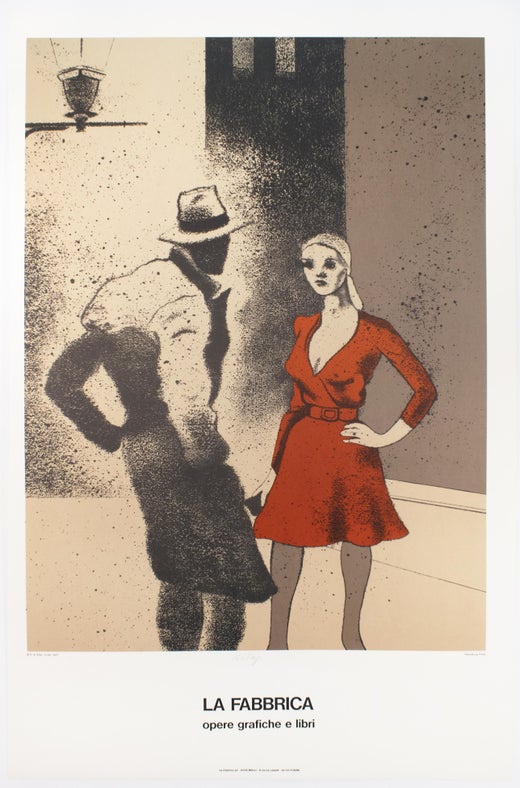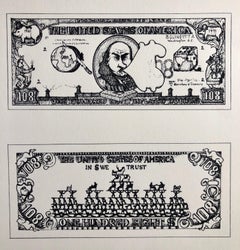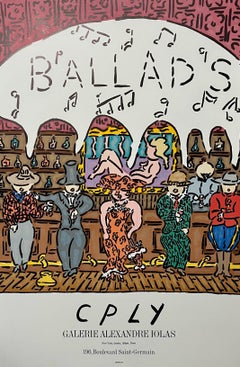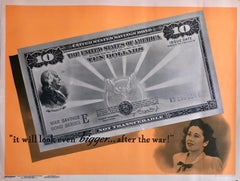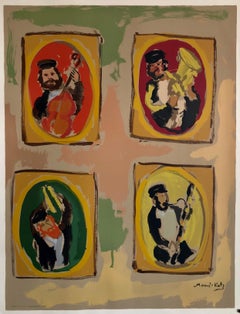Want more images or videos?
Request additional images or videos from the seller
1 of 10
Ronald Brooks KitajVintage Poster British Pop Art 1972 Munich Olympic Swimmer R.B. KItaj1971
1971
$300List Price
About the Item
- Creator:Ronald Brooks Kitaj (1932-2007, American)
- Creation Year:1971
- Dimensions:Height: 39.75 in (100.97 cm)Width: 25 in (63.5 cm)
- Medium:
- Movement & Style:
- Period:
- Condition:minor wear, one minor puncture/abrasion with no loss.
- Gallery Location:Surfside, FL
- Reference Number:1stDibs: LU3823562771
Ronald Brooks Kitaj
Born in Cleveland, Ohio in 1932, R.B. (Ronald Brooks) Kitaj is considered a key figure in European and American contemporary painting. While his work has been considered controversial, he is regarded as a master draftsman with a commitment to figurative art. His highly personal paintings and drawings reflect his deep interest in history; cultural, social and political ideologies; and issues of identity. Among his various honors are election to the American Academy of Arts and Letters in 1982, and election to the Royal Academy in 1985 (the first American since John Singer Sargent to receive this honor.) Numerous retrospective exhibitions of his work include shows at the Hirshhorn Museum in Washington, D.C.; The Jewish Museum, Berlin; The Jewish Museum, London; and the Hamburger Kunsthalle in Germany. Raised in Cleveland, Ohio, and Troy, New York, Kitaj joined the Merchant Marines in 1949.
In 1950, between sailings, he attended classes at the Cooper Union for the Advancement of Science and Art in New York. He went on to study drawing at the Academy of Fine Art in Vienna, Austria. Kitaj moved to Oxford, England in 1957, and enrolled at The Ruskin School of Drawing and Fine Art, University of Oxford. In 1959, Kitaj was accepted into Royal College of Art, London, where he befriended classmate David Hockney. Upon graduation from the RCA, Kitaj signed with Marlborough Fine Art, London, where he had his first solo exhibition in 1963. His art career began in earnest, and he found critical acclaim alongside commercial success. A second solo show followed at Marlborough Gallery, New York, in 1965, and he sold “The Ohio Gang” to The Museum of Modern Art. In 1969, Kitaj taught for a year at the University of California, Los Angeles. In 1976, he coined the term “School of London” in an essay he wrote as curator of the polemical exhibition, “The Human Clay,” at the Hayward Gallery, London. The term, though loose, continues to define a group of stylistically diverse artists, including Kitaj, who were working in London at that time focusing on figural representation. In 1981, he spent a year in Paris, France, where he focused on drawing and use of pastel. In 1994, the Tate Gallery, London, organized a major retrospective of Kitaj’s work. Hostile and personal attacks from some critics led to what Kitaj referred to as the “Tate War.” The exhibition subsequently traveled to the Los Angeles County Museum of Art and the Metropolitan Museum of Art, New York. Kitaj moved to Los Angeles, California, and continued to exhibit with Marlborough Fine Art and the Marlborough Gallery, New York. In 2001 the National Gallery London organized a solo exhibition of paintings: “R.B. Kitaj In the Aura of Cezanne and Other Masters.” Kitaj focused on his “late style” in his Yellow Studio in Westwood and died in 2007. His gift of his archive to the UCLA Library Special Collections was celebrated with exhibitions at the Skirball Cultural Center and UCLA’s Young Research Library.
About the Seller
4.9
Platinum Seller
Premium sellers with a 4.7+ rating and 24-hour response times
Established in 1995
1stDibs seller since 2014
1,822 sales on 1stDibs
Typical response time: 1 hour
Authenticity Guarantee
In the unlikely event there’s an issue with an item’s authenticity, contact us within 1 year for a full refund. DetailsMoney-Back Guarantee
If your item is not as described, is damaged in transit, or does not arrive, contact us within 7 days for a full refund. Details24-Hour Cancellation
You have a 24-hour grace period in which to reconsider your purchase, with no questions asked.Vetted Professional Sellers
Our world-class sellers must adhere to strict standards for service and quality, maintaining the integrity of our listings.Price-Match Guarantee
If you find that a seller listed the same item for a lower price elsewhere, we’ll match it.Trusted Global Delivery
Our best-in-class carrier network provides specialized shipping options worldwide, including custom delivery.You May Also Like
Original Batman Museo Dell'Automobile Torino vintage Italian poster
By (after) Andy Warhol
Located in Spokane, WA
Original poster: BATMAN - Museo Dell'Automobile Torino
Artist: after Andy Warhol.
Size 27.25" x 37" Printed: 1996 in Milan, Italy.
Excellent condition. This pop art Italian poster in perfect condition, ready to frame.
This is the original first printing of the Museo Dell'Automobile Torino (Italy) Batman, Andy Warhol. 'Viaggio in Italia'. This poster features the artwork for Warhol’s unauthorised 1964 film “Batman Dracula”. Excellent condition. Certificate of Authenticity. Printed in Italy. The exhibition poster was for Nov. 30, 1996 - March 9, 1997.
This BATMAN - Museo Dell'Automobile Torino is an Original Vintage Poster, not a reproduction. This poster is in excellent condition.
This is an Original Lithograph Vintage Poster; it is not a reproduction.
This is an Original Lithograph Vintage Poster; it is not a reproduction. Free Continental USA shipping included (saves $69 1st Dibs...
Category
1990s Pop Art Figurative Prints
Materials
Offset
$898 Sale Price
25% Off
H 37 in W 27.25 in D 0.05 in
Yoshitomo Nara - Marching on a Butterbur Leaf, Contemporary Art Print, Pop Art
By Yoshitomo Nara
Located in Hamburg, DE
Yoshitomo Nara (1959, Japanese)
Marching on a Butterbur Leaf, 2019
Medium: Offset print on archival quality paper (incl. 5 stickers, as issued)
Dimensions: 61 × 45.7 cm (24 × 18 in)
...
Category
21st Century and Contemporary Pop Art Figurative Prints
Materials
Offset
Lichtenstein Exhibition Poster - Leo Castelli Gallery
Located in Roma, IT
Lichtenstein Exhibition Poster is a very colorful poster realized in occasion of the artist's exhibition at Leo Castelli Gallery New Yor...
Category
1970s Pop Art Figurative Prints
Materials
Offset, Lithograph
Vintage Jim Dine tool poster Kunsthalle Bern (Saw) neon blue 1970s retro font
By Jim Dine
Located in New York, NY
Original exhibition poster printed on the occasion of Jim Dine's 1971 exhibition at Kunsthalle Bern, featuring Saw, 1971. Against a sea of electric blue, Dine has written “saw” in lo...
Category
1970s Pop Art Figurative Prints
Materials
Paper, Offset
Vintage SIGNED 1969 Eduardo Paolozzi Poster avocado green psychedelic pop art
By Eduardo Paolozzi
Located in New York, NY
A vibrant vintage poster in blue, pink, brown, and classic 1960's avocado green, by Scottish Pop art progenitor Eduardo Paolozzi. Machinery extends upward in two arms like a space-age car engine...
Category
1960s Pop Art Figurative Prints
Materials
Offset
Paolozzi Signed 1969 poster Galerie Mikro vintage futuristic psychedelic pop art
By Eduardo Paolozzi
Located in New York, NY
Printed in chartreuse, dark green, bright yellow, orange, and brown, this surreal scene features a grey-walled room populated with strange machinery and a red chair. Paolozzi creates...
Category
1960s Pop Art Figurative Prints
Materials
Offset
Vintage Jim Dine poster Boymans Museum (Two Ties) red black 1970s retro pop art
By Jim Dine
Located in New York, NY
Original poster produced on the occasion of Jim Dine's 1971 exhibition at the Boymans Museum, Rotterdam. This vintage poster reproduces the artist’s lithograph Two Ties: neckties ske...
Category
1970s Pop Art Figurative Prints
Materials
Offset
James Rosenquist Vintage Poster: Galleria del Milione 1972 full moon landscape
By James Rosenquist
Located in New York, NY
Silhouetted by the night sky, a brimmed hat perches on its stand, hovering above red-speckled ground like an aircraft. The moon shines bright white, and subtle clouds gather at the h...
Category
1970s Pop Art Figurative Prints
Materials
Offset
Vintage Jim Dine Green Bathrobe exhibition poster, 1970s retro pop art font
By Jim Dine
Located in New York, NY
This original, vintage poster on poster stock features one of Jim Dine's most iconic motifs: the bathrobe. In 1964, Dine saw an ad in the New York Times: “The ad shows a robe with the man airbrushed out of it. There was nobody in the bathrobe, but when I saw it, it looked like me.” Standing in for the artist's own body and rife with personal meaning, it provides a framework for limitless formal and stylistic experimentation. Here, the garment is colored bright green and defined by variegated black lines. Numbers label each part of the robe as in an anatomical chart. Bold black lettering reads Jim Dine, Petersburg Press...
Category
1970s Pop Art Figurative Prints
Materials
Paper, Offset
Vintage James Rosenquist Exhibition Poster Dundee City Art Gallery 1974 red
By James Rosenquist
Located in New York, NY
Vintage exhibition poster commemorating James Rosenquist's 1974 exhibition at Dundee City Art Gallery, Scotland. A flashy red border complements an abstract black and white image reproducing Rosenquist's 1972 lithograph Zone, which is based on the artist's 1961 painting with the same title.
"Text reads: Rosenquist Prints. Dundee City Art Gallery Albert Square Dundee DD1 IDA April 13th - May 11th 1974 Open Weekdays 10am-5pm Closed Sundays Admission Free. A Scottish Arts Council exhibition organised in association with the Petersburg Press...
Category
1970s Pop Art Figurative Prints
Materials
Offset
More From This Seller
View All1960's Pop Art Silkscreen Print 108$ Bill Inflation Hand Signed and Numbered
By Oyvind Fahlstrom
Located in Surfside, FL
Öyvind Axel Christian Fahlström (1928–1976) was a Swedish Multimedia artist.
Fahlström was born in Sao Paulo, Brazil, In July 1939 he was sent to Stockholm to visit some distant relatives and after World War II he started to study and later on to work as a writer, critic and journalist. From 1960 until 1976 he was married to the Swedish Pop Art painter Barbro Östlihn.
In 1953 Fahlström had his first solo exhibition, showing the drawing Opera, a room-sized felt-pen drawing. Also in 1953 he wrote Hätila ragulpr på fåtskliaben, a manifesto for concrete poetry, published in Swedish the following year and in English translation (by Mary Ellen Solt, in her anthology "Concrete Poetry. A world view") in 1968.
In 1956 Fahlström moved to Paris and lived there for three years before he moved to Front Street studio, New York City. In New York he worked with different artists and explored his role as an artist further. In 1962 he participated in the New Realists exhibition at the Sidney Janis Gallery, in New York City. His work was included in the 1964 Venice Biennale and he had a solo exhibition at Cordier & Ekstrom Inc., New York. In 1965 he joined the Sidney Janis Gallery.
In 1966 his work Performance of Kisses Sweeter Than Wine was included in 9 Evenings: Theatre and Engineering, organized by Experiments in Art and Technology at the 26th Street Armory, New York. The same year his painting in oil on photo...
Category
1970s Pop Art Figurative Prints
Materials
Lithograph, Screen
Vintage Galerie Alexandre Iolas Ballads Poster William Copley CPLY Mourlot Litho
Located in Surfside, FL
Ballads Galerie Alexandre Iolas Poster by William N. Copley (CPLY)
New-York, Geneve, Milan, Paris
196, Boulevard Saint-Germain
William Nelson Copley (January 24, 1919 – May 7, 1996) also known as CPLY, was an American painter, writer, gallerist, collector, patron, publisher and art entrepreneur. His works as an artist have been classified as late Surrealist and precursory to Pop Art.
William N. Copley was born in New York City in 1919 to parents John and Flora Lodwell; they died shortly after in the 1919 Spanish Flu epidemic. Copley was adopted in 1921 by Ira C. Copley, the owner of sixteen newspaper companies in Chicago and San Diego. Copley was ten years old whereby the family moved to Coronado Island, California.
Copley was sent to Phillips Andover and then Yale University by his adopted parents. He was drafted in the Second World War in the middle of his education at Yale, a decision negotiated by the school and the army. Copley experimented with politics upon returning home from the war, working as a reporter for his father's newspaper.
By 1946, Copley met and married Marjorie Doris Wead, the daughter of a test pilot for the Navy. Doris's sister was married to John Ployardt, a Canadian-born animator and narrator at Walt Disney Studios. Copley and Ployardt soon became friends and Ployardt began introducing Copley to painting and Surrealism. The two traveled to Mexico and New York, discovering art, meeting the artists behind the works, and grasping Surrealist ideas. It was during this time that Copley and Ployardt decided to open a gallery in Los Angeles to exhibit Surrealist works.
Copley and Ployardt tracked down Man Ray while living in Los Angeles. Ray then introduced them to Marcel Duchamp in New York City. There, Duchamp opened many doors for them, introducing the two to New York dealers in Surrealism. In 1948, Copley and Ployardt opened The Copley Galleries in Beverly Hills, displaying works by artists including René Magritte, Max Ernst, Yves Tanguy, Roberto Matta, Joseph Cornell, and Man Ray. Copley moved to Paris in 1949–50, leaving behind his wife and two children to continue to paint. During his time in Paris, he remained in Surrealist circles and continued to paint with a uniquely American style.
Copley's first exhibition took place in Los Angeles in 1951 at Royer's Book Shop. From there Copley participated in numerous solo and group exhibitions worldwide. In 1961, Copley was given an exhibition in Amsterdam by the Stedelijk Museum. The museum became the first public institution to add a Copley to their collection.
Copley's paintings throughout the 1950s and 60s dealt with ironic and humorous images of stereotypical American symbols like the Western saloon, cowboys, and pin-up girls combined with flags. His works during this period were often considered a combination of American and Mexican folk art and melded in well with the new young POP movement occurring in America when he returned to New York in the 1960s. Artists like Andy Warhol, Christo, Roy Lichtenstein and many others were frequent visitors at Copley's studio on Lower Broadway. Copley believed that pop art had always interested him, claiming American pop art had much to do with "self-disgust" and "satire."
In 1967, after a divorce with his second wife, Noma, Copley and new friend Dmitri Petrov decided to publish portfolios of 20th-century artist collaborations with the abbreviation SMS (for "Shit Must Stop"). Copley's Upper West Side loft became a meeting place for performers, artists, curators, and composers to work together on the open-ended collective. The SMS portfolio...
Category
20th Century Abstract Figurative Prints
Materials
Paper, Lithograph, Offset
Vintage Color WWII Poster "it will look even Bigger..." Offset Lithograph
By Franz Oswald Schiffers
Located in Surfside, FL
This is a vintage 1946 public service announcement poster The artwork is bold, clear and direct.
"it will look even bigger… after the war!" Girl looks on longingly at 10 dollar bill....
Category
1940s American Realist Figurative Prints
Materials
Offset
Colorful Russian French Judaica Jewish Shtetl Wedding Lithograph Mourlot Paris
By Mane Katz
Located in Surfside, FL
Mane-Katz (1894-1962) Original Lithograph published by Andre Sauret, Monte Carlo, 1966, printed in France, by Mourlot. The ouvrage sheet is not included. this is from a limited editi...
Category
1960s Modern Figurative Prints
Materials
Lithograph
Colorful Russian French Judaica Jewish Shtetl Wedding Lithograph Mourlot Paris
By Mane Katz
Located in Surfside, FL
Mane-Katz (1894-1962) Original Lithograph published by Andre Sauret, Monte Carlo, 1966, printed in France, by Mourlot. The ouvrage sheet is not included. this is from a limited editi...
Category
1960s Modern Figurative Prints
Materials
Lithograph
Pierre Bonnard Ltd Ed Lithograph Printed at Mourlot Paris 1958 Father and Son
By Pierre Bonnard
Located in Surfside, FL
This is from a limited edition portfolio of original lithographs print Fernand Mourlot in Paris in 1958 from work done in collaboration with Bonnard which began in 1928.
This is f...
Category
20th Century Post-Impressionist More Prints
Materials
Lithograph
